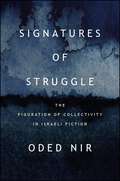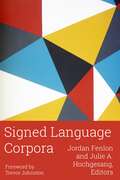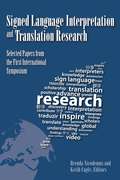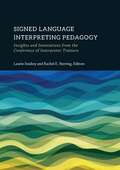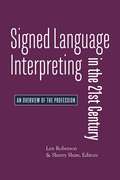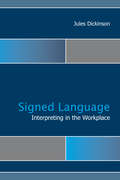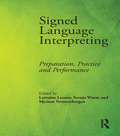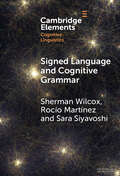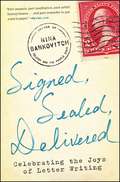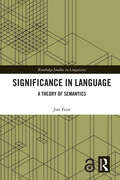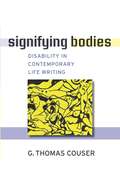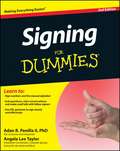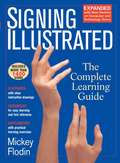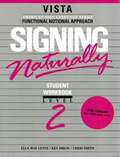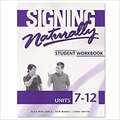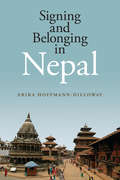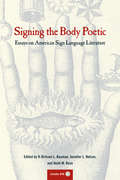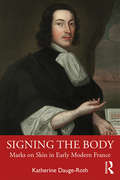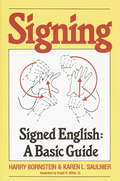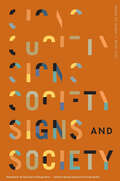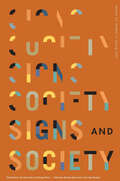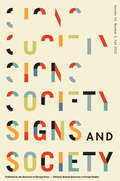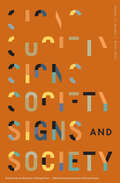- Table View
- List View
Signatures of Struggle: The Figuration of Collectivity in Israeli Fiction (SUNY series in Contemporary Jewish Literature and Culture)
by Oded NirSignatures of Struggle offers a unique perspective on Israeli literature, bringing Marxist cultural critique to bear on a field from which it has hitherto been absent. Oded Nir moves beyond the dominant interpretive horizon of Israeli literary criticism: the relation of literature to national ideology. Rather than reproducing the usual narrative in which fiction resists the nation's goals, Nir demonstrates how, in each historical moment, literary engagement with national ideology is a means to think through social tensions or contradictions internal to Israeli society—to solve in imagination problems that threaten the social order. Focusing on moments of transformation, Nir argues that the 1950s crisis of realism was the result of the failure, rather than the success, of the collective transformative project of the haluzim, the settler vanguard of Zionism. In the 1980s, the postmodern turn expressed a crisis of social imagination, whose origin was the incorporation of Palestinians into the Israeli economy after the 1967 war. Finally, he shows that the ways in which history is imaginatively reworked in contemporary Israeli fiction can only be understood through the context of 1950s and 1980s literature. Authors analyzed include Yigal Mossinsohn, Nathan Shaham, Hanoch Bartov, Yehudit Hendel, Orly Castel-Bloom, Yehudit Katzir, David Grossman, Yehoshua Kenaz, and Batya Gur.
Signatures: Rare Finds
by Roger C. Farr Dorothy S. StricklandIn Rare Finds, you will meet many people who have made rare finds. You may find a character you can relate to and learn from, or some information that starts you on a process of discovery.
Signed Language Corpora (Gallaudet Sociolinguistics #25)
by Jordan Fenlon Julie A. HochgesangJordan Fenlon and Julie A. Hochgesang present a revolutionary contribution to the field of signed language linguistics with Signed Language Corpora, the first volume to provide a comprehensive overview of the creation, development, and use of signed language corpora. This work will advance discussions on corpus linguistics as a methodology and its place in signed language linguistics research. The ability to search corpora to obtain information about the frequency of patterns in language is an important step forward for signed language research. Access to large datasets will expand scholarly understandings of signed language structure in ways never before possible. Through reflective discussions on the processes of creating, using, and utilizing corpora, the editors and contributors hope that other linguists will be inspired to take similar steps. The descriptions provided in this book have been written to provide a framework for those eager to develop or make use of signed language corpora for their respective signed language varieties. Creating signed language corpora is significant not only for linguistic research, but for the long-term preservation of collected texts that include the stories and histories of signed language communities. Additional areas of focus include the use of signed language corpora in applied settings, the ethics of working with signed language communities, and the future of this methodology in research.
Signed Language Interpretation and Translation Research: Selected Papers from the First International Symposium
by Keith Cagle Brenda NicodemusThis volume brings together the best research presented at the first International Symposium on Signed Language Interpreting and Translation Research. Editors Brenda Nicodemus and Keith Cagle have gathered an international group of contributors who are recognized leaders in signed language interpreter education and research. The ten papers in Signed Language Interpretation and Translation Research cover a range of topics, including the need for Deaf perspectives in interpretation research, discourse strategies and techniques that are unique to video relay call settings, the benefits of using sociology as a lens for examining sign language interpreting work, translating university entrance exams from written Portuguese into Libras (Brazilian Sign Language), the linguistic choices interpreters make when interpreting ASL figurative language into English, the nature of designated interpreting, and grammatical ambiguity in trilingual VRS interpreting. The research findings and insights contained here will be invaluable to scholars, students, and practitioners.
Signed Language Interpreting Pedagogy: Insights and Innovations from the Conference of Interpreter Trainers (The Interpreter Education Series #13)
by Laurie Swabey Rachel E. HerringFor over forty years, the Conference of Interpreter Trainers has provided opportunities for advancing teaching and learning in interpreter education. This volume highlights fifteen seminal papers from past conference proceedings, along with newly written responses to the selected papers. Many of the new contributions are co-written by the author of the original paper and one or more emerging scholars, giving readers a historical lens on how the field of signed language interpreting pedagogy has evolved. The volume also calls attention to issues with which the field must urgently contend, such as implementing a Deaf-centric approach, multicultural interpreting curricula, the recruitment and retention of African American/Black students, and social justice. The contributors explore other important topics in interpreter education including ethics, Deaf translation, performance evaluation, consecutive and simultaneous interpreting, discourse analysis, critical thinking, curriculum sequencing, the social construction of learning, and mentoring. Through this collaborative approach featuring more than thirty scholars, Signed Language Interpreting Pedagogy presents a wealth of theoretical and practical information for interpreter educators and their students.
Signed Language Interpreting in the 21st Century: An Overview of the Profession
by Len Roberson Sherry ShawThis text provides interpreting students with a broad knowledge base that encompasses the latest research, addresses current trends and perspectives of the Deaf community, and promotes critical thinking and open dialogue about the working conditions, ethics, boundaries, and competencies needed by a highly qualified interpreter in various settings. This volume expands the resources available to aspiring interpreters, including Deaf interpreters, and incorporates the voices of renowned experts on topics relevant to today’s practitioners. Each chapter provides students with objectives, keywords, and discussion questions. The chapters convey clear information about topics that include credentialing, disposition and aptitude for becoming an interpreter, interpreting for people who are DeafBlind, and working within specialty settings, such as legal and healthcare. A key resource for interpreter certification test preparation, this text follows the interpreter’s ethical, practical, and professional development through a career of lifelong learning and service.
Signed Language Interpreting in the Workplace
by Jules DickinsonThe last forty years have seen a dramatic change in the nature of work, with deaf people increasingly moving into white collar or office-based professions. The rise of deaf professionals has led to employment opportunities for signed language interpreters across a variety of workplace settings, creating a unique set of challenges that require specialized strategies. Aspects such as social interaction between employees, the unwritten patterns and rules of workplace behavior, hierarchical structures, and the changing dynamics of deaf employee/interpreter relationships place constraints upon the interpreter’s role and interpreting performance. Jules Dickinson’s examination of interpreted workplace interactions is based on the only detailed, empirical study of this setting to date. Using practitioner responses and transcripts of real-life interpreted workplace interactions, Dickinson’s findings demonstrate the complexity of the interpreter’s role and responsibilities. The book concentrates on the ways in which signed language interpreters affect the interaction between deaf and hearing employees in team meetings by focusing on humor, small talk, and the collaborative floor. Signed Language Interpreting in the Workplace demonstrates that deaf employees require highly skilled professionals to enable them to integrate into the workplace on a level equal with their hearing peers. It also provides actionable insights for interpreters in workplace settings that will be a valuable resource for interpreting students, practitioners, interpreter trainers, and researchers.
Signed Language Interpreting: Preparation, Practice and Performance
by Lorraine Leeson Svenja Wurm Myriam VermeerbergenSigned language interpreting continues to evolve as a field of research. Stages of professionalization, opportunities for education and the availability of research vary tremendously among different parts of the world. Overall there is continuing hunger for empirically founded, theoretically sound accounts of signed language interpreting to inform practice, pedagogy and the development of the profession. This volume provides new insights into current aspects of preparation, practice and performance of signed language interpreting, drawing together contributions from three continents. Contributors single out specific aspects of relevance to the signed language interpreting profession. These include preparation of interpreters through training, crucial for the development of the profession, with emphasis on sound educational programmes that cover the needs of service users and the wide-ranging skills expected from practitioners. Resources, such as terminology databases, are vital tools for interpreters to prepare successfully for events. Practice oriented, empirical investigations of strategies of interpreters are paramount not only to increase theoretical understanding of interpreter performance, but to provide reference points for practitioners and students. Alongside tackling linguistic and pragmatic challenges, interpreters also face the challenge of dealing with broader issues, such as handling occupational stress, an aspect which has so far received little attention in the field. At the same time, fine-grained assessment mechanisms ensure the sustainability of quality of performance. These and other issues are covered by the eighteen contributors to this volume, ensuring that the collection will be essential reading for academics, students and practitioners.
Signed Language and Cognitive Grammar (Elements in Cognitive Linguistics)
by Sherman Wilcox Rocío Martínez Sara SiyavoshiThis Elements monograph presents a Cognitive Grammar (CG) approach to a range of signed language grammatical phenomena. It begins with a background on the history of sign linguistics, focusing on what was a widely-held belief that signs are simply gestures. The first section traces the modern linguistic examination of signed languages, focusing on Stokoe and his demonstration that these languages exhibit phonology and duality of patterning. Next, we present some fundamental principles that are foundational for cognitive linguistics and sign linguistics. In a section on Cognitive Grammar, we present a brief overview of CG principles, constructs, and models. Section 4 presents extensive analyses of signed language constructions applying CG, including nominal grounding; the concepts of Place and placing; a CG approach to 'agreement' constructions in signed languages; reported dialogue; grammatical modality; and the grammatical meaning of facial displays. A final section examines the controversial role of gesture in grammatical constructions.
Signed, Sealed, Delivered
by Nina SankovitchThe author of the much-admired Tolstoy and the Purple Chair goes on a quest through the history of letters and her own personal correspondence to discover and celebrate what is special about the handwritten letter. Witty, moving, enlightening, and inspiring, Signed, Sealed, Delivered begins with Nina Sankovitch's discovery of a trove of hundred year- old letters. The letters are in an old steamer trunk she finds in her backyard and include missives written by a Princeton freshman to his mother in the early 1900s. Nina's own son is heading off to Harvard, and she hopes that he will write to her, as the Princeton student wrote to his mother and as Nina wrote to hers. But times have changed. Before Nina can persuade her child of the value of letters, she must first understand for herself exactly what it is about letters that make them so significant--and just why she wants to receive letters from her son. Sankovitch sets off on a quest through the history of letter writing--from the ancient Egyptians to the medieval lovers Abelard and Heloise, from the letters received by President Lincoln after his son's death to the correspondence of Edith Wharton and Henry James. Sankovitch uncovers and defines the specific qualities that make letters so special, examining not only historical letters but also the letters in epistolary novels, her husband's love letters, and dozens more sources, including her son's brief reports from college on the weather and his allowance. In this beautifully written book, Nina Sankovitch reminds us that letters offer proof and legacy of what is most important in life: love and connection. In the end, she finds, the letters we write are even more important than the ones we wait for.
Significance in Language: A Theory of Semantics (Routledge Studies in Linguistics)
by Jim FeistThis book offers a unique perspective on meaning in language, broadening the scope of existing understanding of meaning by introducing a comprehensive and cohesive account of meaning that draws on a wide range of linguistic approaches. The volume seeks to build up a complete picture of what meaning is, different types of meaning, and different ways of structuring the same meaning across myriad forms and varieties of language across such domains, such as everyday speech, advertising, humour, and academic writing. Supported by data from psycholinguistic and neurolinguistic research, the book combines different approaches from scholarship in semantics, including formalist, structuralist, cognitive, functionalist, and semiotics to demonstrate the ways in which meaning is expressed in words but also in word order and intonation. The book argues for a revised conceptualisation of meaning toward presenting a new perspective on semantics and its wider study in language and linguistic research. This book will appeal to scholars interested in meaning in language in such fields as linguistics, semantics, and semiotics. The Open Access version of this book, available at http://www.taylorfrancis.com has been made available under a Creative Commons Attribution-Non Commercial-No Derivatives 4.0 license.
Signifying Bodies
by G. Thomas Couser"Thomas Couser'sSignifying Bodiescomes at a crucial moment when debates about physician assisted suicide, genetic engineering, and neo-natal screening are raising the question of what constitutes a 'life worth living' for persons with disabilities. Couser's work engages these debates by exploring the extensive number of personal narratives by or about persons with disabilities. As Couser brilliantly demonstrates through synoptic readings, these works challenge the 'preferred rhetorics' by which such narratives are usually written (triumphalist, gothic, nostalgic) while making visible the variegated nature of embodied life. " ---Michael Davidson, University of California, San Diego "Signifying Bodiesshows us that life writing about disability is . . . everywhere. . . . From obituary to documentary film to ethnography to literary memoir to the law, the book casts a wide net, detailing how various written and filmed responses to disability both enact and resist conventional narrative patterns. [This] not only broadens our idea about where to look for life writing, but also demonstrates how thoroughly stereotypes about disability mediate our social and artistic languages---even when an author has (so-called) the best intentions. " ---Susannah B. Mintz, Skidmore College Memoirs have enjoyed great popularity in recent years, experiencing significant sales, prominent reviews, and diverse readerships. Signifying Bodiesshows that at the heart of the memoir phenomenon is our fascination with writing that focuses on what it means to live in, or be, an anomalous body---in other words, what it means to be disabled. Previous literary accounts of the disabled body have often portrayed it as a stable entity possibly signifying moral deviance or divine disfavor, but contemporary writers with disabilities are defining themselves and depicting their bodies in new ways. Using the insights of disability studies and source material ranging from the Old and New Testaments to the works of authors like Lucy Grealy and Simi Linton and including contemporary films such asMillion Dollar Baby, G. Thomas Couser sheds light on a broader cultural phenomenon, exploring topics such as the ethical issues involved in disability memoirs, the rhetorical patterns they frequently employ, and the complex relationship between disability narrative and disability law. G. Thomas Couser is Professor of English at Hofstra University.
Signing For Dummies
by Angela Lee Taylor Adan R. Penilla IIThe fast and easy way to grasp this evolving and growing languageAmerican Sign Language (ASL) is something we've all seen deaf people use in restaurants, hospitals, airports, and at work. The communication is fascinating to watch; to see people sharing ideas by using handshapes and body language is remarkable in a world so defined by sound. This new edition of Signing For Dummies gives you a general understanding of the properties of Sign, as well as an understanding of deaf culture. Designed to act as an introduction or a refresher, the book focuses solely on ASL, which is the most commonly used sign language in the United States. Categorized by subject, this illustrated guide covers grammar and sentence structure, along with the tools to get you going in basic conversation by knowing how to introduce and greet people; ask questions and make small talk; order food and chat with salespeople; handle medical emergencies; talk on the phone; get around town for fun or business; and much more. Plus, it stresses how ASL isn't just about using your fingers, hands, and arms, but also about facial expression and body language.More than 25 percent new and revised content, including the latest technological advances for the deaf; contact signing, code mixing, code switching, interpreting as a profession, and regionalism in signingPacked with "Fun & Games" sections that invite you to practice specific signsHundreds of illustrations throughout, plus a video CD featuring demonstrations by ASL signers showing actual conversationsSigning For Dummies is the fast and fun way to get you moving your hands, body, and face to convey meaning that reaches beyond linguistic barriers.
Signing Illustrated
by Mickey Flodin"Whether you have a casual interest in signing, or a sincere desire to communicate with deaf people, Signing Illustrated provides all the basic vocabulary and instructions you need to learn how to sign. Even though it takes considerable time to become a proficient signer, you will soon be signing basic concepts after studying only a chapter or two. Persons who are deaf are pleased when others learn their language, and they are patient and understanding with the beginning signer." Each chapter covers a specific category of signs, making this a useful reference tool.
Signing Naturally Level 2
by Cheri Smith Ella Mae Lentz"Each of the five units in Level 2 revolves around a major language function: locating things around the house; complaining and making requests; talking about life events, nationalities and family histories; describing objects; talking about the weekend."--Introduction.
Signing Naturally: Student Workbook Level 1
by Cheri Smith Ella Mae Lentz Ken MikosAn excellent resource book, with over 1000 signs and 100 useful phrases. Activities are video-interactive, with the emphasis on language in context, featuring useful vocabulary and expressions. Readings about culture and language are included to enhance your understanding of ASL and the Deaf experience.
Signing Naturally: Student Workbook, Units 7-12
by Cheri Smith Ella Mae Lentz Ken MikosDesigned to give students a deeper insight into ASL and Deaf culture. Signing Naturally Units 7-12 Student Workbook offers homework assignments that support what you've learned in the classroom. Signing Naturally Units 7-12 Student Workbook also features Deaf culture articles and profiles of legendary Deaf leaders. There's also a topic index to help you find signs and information easily. The Signing Naturally Units 7-12 Student Workbook also includes over seven hours of ASL video material on two DVDs signed by 13 skilled native signers. Signing Naturally Units 7-12 Student Workbook is everything you need to bring your ASL skills BEYOND the classroom.
Signing and Belonging in Nepal
by Erika Hoffmann-DillowayWhile many deaf organizations around the world have adopted an ethno-linguistic framing of deafness, the meanings and consequences of this perspective vary across cultural contexts, and relatively little scholarship exists that explores this framework from an anthropological perspective. In this book, Erika Hoffmann-Dilloway presents an accessible examination of deafness in Nepal. As a linguistic anthropologist, she describes the emergence of Nepali Sign Language and deaf sociality in the social and historical context of Nepal during the last decades before the Hindu Kingdom became a secular republic. She then shows how the adoption of an ethno-linguistic model interacted with the ritual pollution model, or the prior notion that deafness results from bad karma. Her focus is on the impact of these competing and co-existing understandings of deafness on three groups: signers who adopted deafness as an ethnic identity, homesigners whose ability to adopt that identity is hindered by their difficulties in acquiring Nepali Sign Language, and hearing Nepalis who interact with Deaf signers. Comparing these contexts demonstrates that both the ethno-linguistic model and the ritual pollution model, its seeming foil, draw on the same basic premise: that both persons and larger social formations are mutually constituted through interaction. Signing and Belonging in Nepal is an ethnography that studies a rich and unique Deaf culture while also contributing to larger discussions about social reproduction and social change.
Signing the Body Poetic: Essays on American Sign Language Literature
by W. J. T. Mitchell Jennifer L. Nelson H-Dirksen L. Bauman William C. Stokoe Heidi M. RoseThis unique collection of essays at last brings a dazzling view of the literary, social, and performative aspects of American Sign Language to a wide audience. The book presents the work of a renowned and diverse group of deaf, hard-of-hearing, and hearing scholars who examine original ASL poetry, narrative, and drama. The book showcases the poems and narratives under discussion in their original form, providing access to them for hearing non-signers for the first time. The book provides new insight into the history, culture, and creative achievements of the deaf community while expanding the scope of the visual and performing arts, literary criticism, and comparative literature.
Signing the Body: Marks on Skin in Early Modern France
by Katherine Dauge-RothThe first major scholarly investigation into the rich history of the marked body in the early modern period, this interdisciplinary study examines multiple forms, uses, and meanings of corporeal inscription and impression in France and the French Atlantic from the late sixteenth through early eighteenth centuries. Placing into dialogue a broad range of textual and visual sources drawn from areas as diverse as demonology, jurisprudence, mysticism, medicine, pilgrimage, commerce, travel, and colonial conquest that have formerly been examined largely in isolation, Katherine Dauge-Roth demonstrates that emerging theories and practices of signing the body must be understood in relationship to each other and to the development of other material marking practices that rose to prominence in the early modern period. While each chapter brings to light the particular histories and meanings of a distinct set of cutaneous marks—devil’s marks on witches, demon’s marks upon the possessed, devotional wounds, Amerindian and Holy Land pilgrim tattoos, and criminal brands—each also reveals connections between these various types of stigmata, links that were obvious to the early modern thinkers who theorized and deployed them. Moreover, the five chapters bring to the fore ways in which corporeal marking of all kinds interacted dynamically with practices of writing on, imprinting, and engraving paper, parchment, fabric, and metal that flourished in the period, together signaling important changes taking place in early modern society. Examining the marked body as a material object rife with varied meanings and uses, Signing the Body: Marks on Skin in Early Modern France shows how the skin itself became the register of the profound cultural and social transformations that characterized this era.
Signing: A Basic Guide
by Karen L. Saulnier Harry Bornstein Ralph R. MillerNow available as an eBook, this quick-reference dictionary is for everyone who knows, cares about, or wants to communicate with someone who is deaf or hearing impaired. Designed by Harry Bornstein and Karen L. Saulnier, two of the foremost experts on sign language, Signing features more than one thousand black-and-white illustrations created specifically for hearing and non-hearing people who want to learn how to sign. Packed with grammar tips and vocabulary words arranged by subject for easy reference, Signing is a comprehensive guide to mastering the basics of Signed English and can be used alone or in conjunction with the Living Language video, Say it By Signing.
Signs and Society, volume 10 number 1 (Winter 2022)
by Signs and SocietyThis is volume 10 issue 1 of Signs and Society. Signs and Society is an open-access, multidisciplinary journal in the humanities and social sciences focusing on research that examines the role of sign processes (or semiosis) in social interaction, cognition, and cultural formations. Focusing directly on semiosis in its multiple dimensions, the journal aims to promote collaborative translation across analytical categories and technical vocabularies already established in anthropology, linguistics, semiotics, and related disciplines, and to uncover unanticipated parallels in the ways semiosis is manifest in diverse empirical domains.
Signs and Society, volume 10 number 2 (Spring 2022)
by Signs and SocietyThis is volume 10 issue 2 of Signs and Society. Signs and Society is an open-access, multidisciplinary journal in the humanities and social sciences focusing on research that examines the role of sign processes (or semiosis) in social interaction, cognition, and cultural formations. Focusing directly on semiosis in its multiple dimensions, the journal aims to promote collaborative translation across analytical categories and technical vocabularies already established in anthropology, linguistics, semiotics, and related disciplines, and to uncover unanticipated parallels in the ways semiosis is manifest in diverse empirical domains.
Signs and Society, volume 10 number 3 (Fall 2022)
by Signs and SocietyThis is volume 10 issue 3 of Signs and Society. Signs and Society is an open-access, multidisciplinary journal in the humanities and social sciences focusing on research that examines the role of sign processes (or semiosis) in social interaction, cognition, and cultural formations. Focusing directly on semiosis in its multiple dimensions, the journal aims to promote collaborative translation across analytical categories and technical vocabularies already established in anthropology, linguistics, semiotics, and related disciplines, and to uncover unanticipated parallels in the ways semiosis is manifest in diverse empirical domains.
Signs and Society, volume 11 number 1 (Winter 2023)
by Signs and SocietyThis is volume 11 issue 1 of Signs and Society. Signs and Society is an open-access, multidisciplinary journal in the humanities and social sciences focusing on research that examines the role of sign processes (or semiosis) in social interaction, cognition, and cultural formations. Focusing directly on semiosis in its multiple dimensions, the journal aims to promote collaborative translation across analytical categories and technical vocabularies already established in anthropology, linguistics, semiotics, and related disciplines, and to uncover unanticipated parallels in the ways semiosis is manifest in diverse empirical domains.
